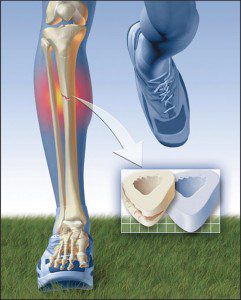By Myles Rubin Samotin, MD – Board Certified Orthopaedic Surgeon, Fellowship Trained in Foot and Ankle –
 You may have heard the term stress fracture, but just what is it and how does one get it? A stress fracture is exactly what it states it is, a fracture of the bone caused by “stress” to the bone. It is a “microfracture” of the bone, similar to a crack in the concrete of your driveway. It occurs due to several causes, but most of the time due to the muscles that support the body become overly fatigued and the stress transfers to the bone, sometimes resulting in a fracture.
You may have heard the term stress fracture, but just what is it and how does one get it? A stress fracture is exactly what it states it is, a fracture of the bone caused by “stress” to the bone. It is a “microfracture” of the bone, similar to a crack in the concrete of your driveway. It occurs due to several causes, but most of the time due to the muscles that support the body become overly fatigued and the stress transfers to the bone, sometimes resulting in a fracture.
The people who get this fracture are people who either do repetitive exercises, (people who constantly are running, or doing consistent exercises that overexert the muscles) or people who have problems with bone quality or density, due to medical problems, poor nutrition, or osteoporosis. The muscles are not strong enough and the bone fractures. As you can imagine, these stress fractures rarely involve upper extremities, since we don’t put pressure on these bones on a consistent basis. These fractures almost always involve the tibia (shinbone) or one of the many bones of the foot, many times involving a metatarsal bone.
Women are much more likely to suffer these, since estrogen, which helps support bones, tends to decrease as women age. Long distance runners, tri-athletes are very susceptible to these fractures, BUT, many “snowbirds” will suffer from these when they first come down to Florida, since they will start a strong exercise program without properly building up the supportive muscles.
The symptoms of stress fractures are relatively simple: PAIN. This pain will increase as you continue putting pressure and stress on the affected bone, and will subside when the bone can rest.
The first thing in proper diagnosis is to a see the proper specialist who can give a correct diagnosis. Since the bones associated with stress fractures involve mainly the foot and ankle, then a foot and ankle specialist, with orthopedic experience is the proper medical person to see. He will order the proper tests, to diagnose the stress fracture. Most normal X-Rays will NOT show any fracture, and a person may be misdiagnosed because of this. Special tests such as bone scans and MRI’s can make the proper diagnosis.
When you see your orthopedic foot and ankle specialist, he will order the proper tests and will make the diagnosis of a stress fracture. He will rest your leg by placing it into a walking boot to give it the chance to heal. The most important thing to remember during this time of rest is that you MUST give it enough time for the fracture to heal. Several weeks of rest may be necessary. If you start to use the bone too early, the fracture may not have totally healed and another stress fracture may result. Therefore, care must be given to properly let the stress fracture mend. All patients must remember that the BONE IS FRACTURED. Give it time to heal.
Anytime that a lower extremity has been consistently painful over a period of time, the diagnosis of stress fracture cannot be ruled out. You should seek your orthopedic foot and ankle specialist. I am the only fellowship trained orthopaedic foot and ankle specialist, with clinical experience of over 12 years in the Naples area. I believe my combination of extensive education and clinical experience along with willingness to use new techniques in a state-of-the-art office allows me to give the best possible care to ALL your foot and ankle needs. I know that I can give you the orthopaedic foot and ankle distinction.
Myles Rubin Samotin, M.D. P.A.
713 E. Marion Avenue, Suite 135
941-661-6757








